Calling and Data
The Verizon version of the Samsung Galaxy Nexus works on Verizon's CDMA network for voice and EV-DO Rev. A 3G as well as their LTE 4G network for data. Verizon's LTE phones have two cellular radios, one for CDMA and one for LTE, and the signal bars report on whatever network your phone is currently using for data. Older LTE phones reported only the 3G signal in bars, even if they were on LTE, so don't use bars as your only guide. According to the phone status settings applet, where you can see the decibel rating of the current connection, the Galaxy Nexus does as well as other recent Verizon LTE phones for LTE reception. 3G reception is weaker than our Motorola Droid Bionic and RAZR but we saw none of the connection waffling that we experienced on our Bionic, Droid RAZR and Samsung Droid Charge, where the phone bounced between 3G and 4G radios frequently, thus destroying battery life and connection reliability. The Galaxy Nexus managed to hold onto a bar or two of LTE (-105db) in our Verizon-challenged area of the Dallas metroplex, and rarely fell to 3G unless we put the phone in a pants pocket. Our other Verizon phones spend most of their time on 3G here with the exception of the HTC Rezound that uses Qualcomm's highly integrated cellular and CPU chips for more stable reception and improved battery life.
LTE 4G data speeds in our weak reception area averaged 10Mbps down and 1Mbps up with a pretty poor -105db signal. In stronger reception areas (-80 to -90db) we averaged near 20Mbps down and 16Mbps up. With and excellent -75 to -80db signal, with saw up to 33Mbps down and 17Mbps up according to the Speedtest.net app. Our 3G speeds averaged 1.1Mbps down and 900k up with a -93db signal. That's not terribly impressive for a high end smartphone on Verizon Wireless, and so far it seems that 3G isn't the Galaxy Nexus' strong point, though LTE is solid. Verizon has stated that they're working on reception issues and will issue a software or firmware fix, so don't lose hope.
The phone has the usual mobile hotspot feature so you can share its high speed connection with tablets and laptops that are stuck in WiFi-land. The feature is available with 6 gig $50/month and higher data plans with mobile hotspot. The phone uses an LTE micro SIM card, as does the Moto Droid RAZR, and Verizon is moving toward this smaller SIM card for their LTE devices (even tablets like the new Motorola Droid XYBoard 10.1 and 8.2). Verizon's LTE SIM cards aren't the same as GSM SIM cards, but you do get one matching convenience: you can swap your SIM card from one Verizon LTE phone to another and your phone number and account follow the SIM rather than the phone. So if you have a Droid RAZR micro SIM and put that in your Samsung Galaxy Nexus, you're good to go. There's no need to activate the phone or dial *228 (in fact you should NOT use the *228 activation function on a Verizon LTE phone).
Voice quality is excellent, even with a weak signal. Though 3G reception is worse than average on our unit, it does well with CDMA 1xRTT voice (that's the cellular connection type Verizon uses for voice calls, they do not use EV-DO for voice). We didn't experience more dropped calls than average on Verizon (which is to say very, very few) and call quality for both incoming and outgoing voice are clear, full and easy to understand. As a voice phone, the Samsung Galaxy Nexus beat our HTC Rezound (whose strong point isn't voice quality) and even our mighty Bionic that does better than average for voice.
Performance and Horsepower
This gets a little hairy for those of you who adore synthetic benchmarks. Some benchmark apps need updating for the new OS version, and quadrant is notably wrong in its result. But as far as we can tell, AnTuTu does its job correctly (score 5985), as does the Sunspider JavaScript test (it doesn't matter what OS you're running for Sunspider, it's OS and platform agnostic). Experientially, the clean OS plus ICS' speed improvements make the Nexus a very fast Android phone. Lag and Android seem to appear together in sentences all over the web, but we can tell you that you'll experience almost none on the Galaxy Nexus. Fluid operation and good speed are hallmarks of the Nexus line, and the Galaxy Nexus is no different.
Video playback of locally stored MPEG4 content up to 1080p HD is excellent (including over HDMI), as is streaming HQ YouTube via the included player. Netflix videos look good and play smoothly and Adobe Flash 11 controls are manageable (Adobe released Flash for ICS nearly a day after the Galaxy Nexus went on sale, and didn't make it in time for our video review). When you buy a Nexus, you don't get manufacturer customizations that are often useful like pull-down access to wireless controls or additional video codecs. If you want to go beyond the basic set of Android video codecs (MPEG4 with AAC audio), you'll need third party players and codecs.
Benchmarks
Android OS 4.03 Ice Cream Sandwich
Our device self-updated from 4.0 to 4.03 when we booted it for the first time. This update takes care of some bugs that apparently held back the Verizon release. Ice Cream Sandwich is an essay unto itself, but here's the Readers Digest version. It combines UI elements of the phone-centric Gingerbread OS with those of the Honeycomb tablet OS. With Ice Cream Sandwich, phones and tablets will run the same OS, so there's no learning curve for owners of both and there's less work for developers who wish to make apps for both phones and tablets. Honeycomb elements are much more numerous, with its app drawer that has a shortcut to the Android Market at the top right corner, and you can press and hold an icon to uninstall and app without having to go into settings->applications, but apps built into ROM like Gmail still can't be removed. The task switcher (one of the nicest ICS features) comes straight from Honeycomb. But Google has improved these Honeycomb UI features: you can now swipe away apps from your task switcher list, menus live in one instead of two possible locations and widgets are accessible not just on the multi-page home screen but as a tab on the app launcher screen for easier access. Still, for all the complaints against Honeycomb's UI, I think it's funny that so many reviewers have fallen in love with ICS, given how much like Honeycomb it is. For the record: I enjoy Honeycomb just fine, thank you. I also like ICS and find it a solid evolution rather than an Android OS revolution or revelation. It's getting more consistent, more user friendly and faster. That said, it's still a very customizable and open experience, so it will never have the brain-dead easy navigation of mobile operating systems with more locked down user interfaces like iOS and Windows Phone. Android is still a little wild west, but that's also its appeal for those who like to customize and tinker.
Camera
The most talked about ICS camera tweak beyond the speed increase for shooting photos is facial recognition for unlocking the phone. Instead of swiping to unlock, using a PIN code or a pattern, the front 1.3MP camera wakes up and looks at you so it can unlock the phone. This is extremely quick, and it worked well even in low light where our laptops with similar features failed. I never had to wiggle my head to the sweet spot or change my expression. When I handed the phone to other women, it never mistook them for me. However, a photo of you can fool it: keep that in mind if you carry deep, dark secrets in your phone. PIN and pattern lock are the most secure.
The front camera works with GTalk video chat and it worked well with Skype over 4G and WiFi in our tests. The rear 5 megapixel camera with LED flash isn't Samsung's top of the line. Quality is good but not "wow" good, and the Galaxy S II line have all moved up to 8 megapixel cameras. The real story here is Android OS 4's improved camera controls and much faster focus and shot times. The minute you tap that on-screen shutter button, it takes the shot with no perceived delay. That means you'll have to adjust your photo-taking habits and hold the phone very still while pressing the on-screen button or you'll get a blurry shot. The camera also takes good panorama shots, and that feature is easy to use.
Battery Life
LTE is Verizon's glory and albatross. Their already widespread LTE 4G network and its super-fast data speeds are wonderful and no doubt sell lots of phones. But unlike GSM LTE phones like the Samsung Galaxy S II Skyrocket, CDMA phones with LTE (that's what Verizon uses), must have two cell chips inside, and that's very hard on battery life. Someday we'll see single chip solutions (Moto claims to be working this one hard), but until then, if you're a moderate to heavy smartphone user, resign yourself to buy a spare battery and perhaps a car charger. The Samsung Galaxy Nexus runs on a second generation chipset, so it fares better than early Verizon LTE phones like the HTC Thunderbolt. It has as much staying power as the Droid RAZR, but the Nexus has a removable battery for extra brownie points. The Galaxy Nexus has an 1850 mAh Lithium Ion battery that we had to charge nightly with moderate use with a steady (though not very strong) LTE signal. If you wish to save battery life, you can change the wireless settings to use the CDMA 3G network only. We saw a 33% increase in battery life when running 3G only.
Conclusion
The Samsung Galaxy Nexus on Verizon Wireless is one of our top picks for that carrier. Yes, 3G reception could be better, but Verizon says they're working on an update. And in the meantime, LTE works very well in our tests, data speeds on 3G are decent and voice quality is tops. The phone is fast and pure. For enthusiasts, it's exciting to get Ice Cream Sandwich RIGHT NOW. For everyday users who care less about OS versions and getting OS updates before everyone else, the appeal is a fast and stable phone. But you do lose out on those sometimes handy manufacturer customizations like widgets that help you jump right into social networking, and quick access controls for wireless, brightness and other key settings. You'll also have to seek out your own video codecs if you're a DivX type.
Why don't we just say it's the best phone on Verizon? Because some of you like those aforementioned manufacturer customizations and the creature comforts they bring. Some of you like really high quality materials and the Motorola Droid RAZR wins there with its Kevlar, Gorilla glass and metal frame. If you're in a reception challenged area (particularly where 3G and 4G bounce back and forth), the Nexus is one of Verizon's better phones, but the HTC Rezound is the all time winner with its rock solid stable reception. That's why carriers sell more than one phone in each price tier. But if you are a techie, just do it: get the Samsung Galaxy Nexus; nothing else feeds the geek like the Nexus does.
Price: $299 with a 2 year contract, $649 without contract
Websites: www.verizonwireless.com, www.samsung.com
|
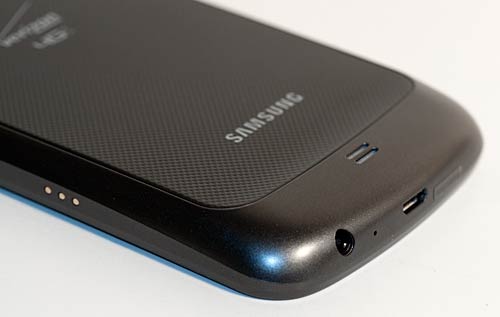
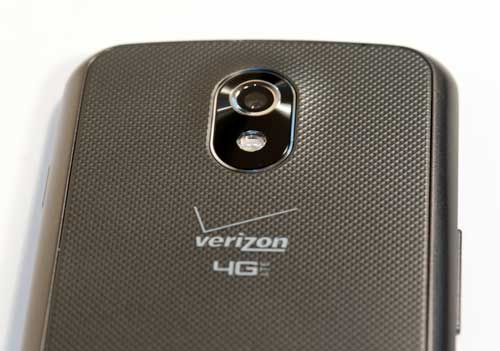

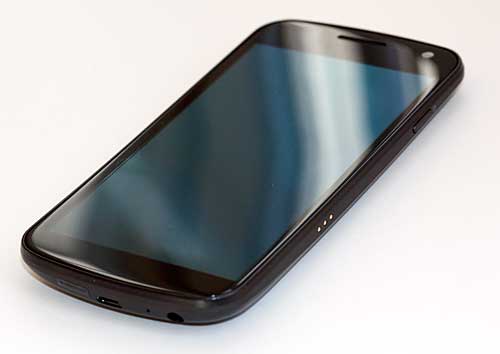
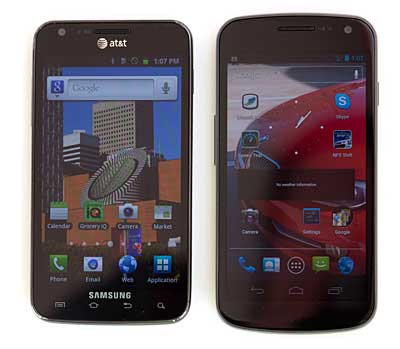
Above: the Samsung Galaxy S II Skyrocket LTE Android phone on AT&T and the Galaxy Nexus.
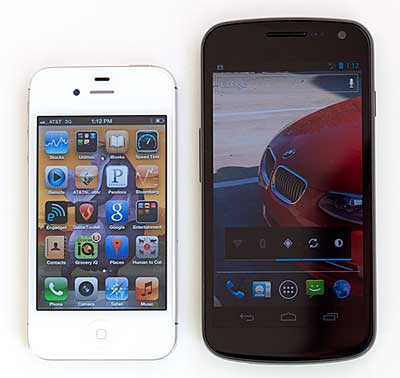
Above: the iPhone 4S and Galaxy Nexus. |

